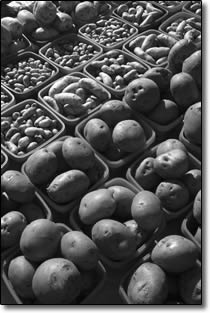|
by Chef Boy Ari

A few weeks ago I encouraged you to
pluck zee nectar and relish the exquisite pleasures available at
the apex of the growing season. That was a fleeting moment of sweet
corn and peaches, of right here, right now, as we sipped from the
cream of summer.
Now our hemisphere is
tilting away from the sun, and suddenly, every day is noticeably
shorter. The basil is turning brown in the cold nights, the apples
and leaves are blowing off the trees. It's time to prepare for
winter. On my stove right now, cooking slowly, there is plum
chutney, which I plan to serve with the wild game that I hope will
soon line my freezer. Meanwhile, the farmers are weary. Months of
constant movement and sleep deprivation have caught up, and you can
find them in their fields, gazing absently into the distance,
surrounded by great dirty piles of potatoes, onions, shallots,
beets, turnips, rutabaga and other bounty. Garlic hangs inside
barns, squash cures in the sun, and carrots stand ready for
digging. Now is the time when produce is cheap.
While the time for
plucking zee nectar has sadly passed, the task at hand is even more
important. This is the glue behind the glitter, the time to stash
the staples and do the work necessary to stock a year-round
pantry.
Sure, you can also buy
your food at the store when you need it. But when February rolls
around and you're paying $2 for a pound of potatoes, here's why:
you're paying for months worth of storage space for that food; you
are paying for shipping the food from that storage space, wherever
it may be, to the store. And in Februaryas opposed to nowpotatoes
are scarce, and the law of supply and demand conspires with these
other factors to jack up the price.
This discussion, of
course, is about more than money. A large stockpile of food
provides a unique brand of satisfaction, as does freedom from
always running to the store. And when you do go shopping, it's for
things like flour, oil, rice and chocolate. At meal time, you look
down at your plate and see ingredients that you recognize: venison
with homemade chutney next to potatoes, with a side of kale, which
was cooked with onions, garlic and maybe some morels from last
spring. How much you store depends on what kind of facilities you
have for frozen and cool storage. Owning a freezer is key.
Meanwhile, books abound with building instructions and diagrams for
root cellars, ranging from glorified holes in the ground to
wood-framed, stone-lined caves to railroad boxcars buried in the
sides of hills.
Those of us who don't
have hills or box cars or holes to dig might yet have an
unfinished, unheated basement or crawlspace, or an unheated garage
that stays cool all winter. Last year, it got so cold during a
January cold snap that I lost my squash and onions. Darn! But
everything else survived.
Those root cellar plans
are usually found in the same books that give instructions for
preserving your food. Another good source of information on food
preservation is Joy of
Cooking . And
while my words are admittedly a pale substitute for such dense
compendiums of information, I'll leave you with a few tips to
consider as you prowl the aisles of the farmer's market looking for
grub to stash: Don't wash food before storing it. Dampness invites
mold, and scrubbing can compromise the protective skin on some
veggies. Better to clean at the time of use.
Keep potatoes in a dark, cool, dry place, in ventilated bags, or
packed with straw in boxes. Store winter squash on shelves in a
cool, dark place. Check them periodically for mold, which you
should wipe off with a cloth dipped in vegetable oil. If mold
starts to take over a squashor anything elseget rid of it ASAP,
before it spreads.
Onions, garlic and shallotsaka the edible liliesdo well in mesh
bags hung in cool, dry, ventilated spaces. Leeks, the other edible
lily, are best frozen.
True connoisseurs of kale bide their time until after a frost,
which makes the leaves sweeter. Then they blanch the kale and
freeze it.
Ripe apples, pears and other fruits give off a gas called
ethylene, a ripening hormone. If you store ripe apples near
potatoes, the potatoes will sprout. Over-ripe fruit will quickly
cause neighboring fruit to ripenhence the clich`E9 about one bad
apple. Thus, sort your fruit carefully and store in a
well-ventilated place away from vulnerable foods.
Tomatoes can stay in the ground, covered, through light frosts.
But before a big one hits, I pull the whole plant, with tomatoes
attached, and hang it upside down near the apples, if available,
which will hopefully encourage the tomatoes to turn red. Even if
you don't have apples, most of the farmers I know agree that
hanging the plants whole is the best method for late-season tomato
ripening.
Now go and make some hay, so to speak, while the sun's still
shining! •
|